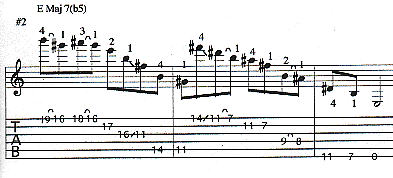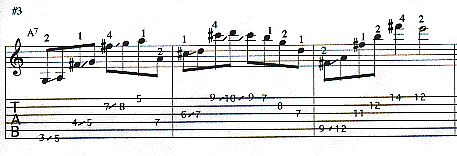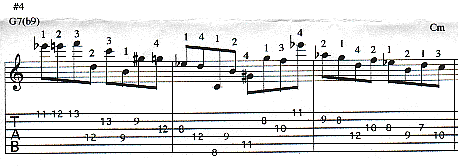Hello, it's good to be back! Do you find yourself going up and down scales too much, and wish you could break it up a little? Well, in this column we are going to talk about intervalic lines - meaning moving in intervals. For example: Major 3rds, Perfect 4ths, 5ths, Major 6ths, Octaves, etc. By thinking this way you will learn scakes on the neck much faster, which will improve your soloing and will add a cool twist to your playing. OK, let's check it out.
Example 1 is an E Lydian scale (E F# G# A# B C# D#) with the corresponding scale formula being (1, 2, 3, #4, 5, 6, 7). Instead of playing this scale all in the same octave, I moved the G#, A#, D# and E up an octave. The pattern is two notes low, two notes high, however, you could use any combination you like. A fancy word for this technique is called octave displacement.
MP3 - Example 1 - Slow
MP3 - Example 1 - Fast

In Example 2, we have a line which also uses the E Lydian scale. This line starts out with an E Major triad (E G# B), and with an added A# it gives us that cool Lydian flavor. After the slide on beat 4, we jump down a fifth from the F# on the G string to the B note on the A string. So we have a little string skipping here. In the second bar we skip three strings. On beat 2 of the second bar we descend using a B Major 7th arpeggio (B D# F# A#). Notice after the F# on the B string we jump down a fifth to the D string, and down another fifth from the A# on the D string descending to the E string. By moving these notes around like this you can get some really cool sounds.
MP3 - Example 2 - Slow
MP3 - Example 2 - Fast

In Example 3 we are using a Mixolydian scale (A, B, C# D E F# G) with the scale formula (1, 2, 3, 4, 5, 6, b7). There are a kot of slides in this example. Pay close attention to the fingerings above the notation. In the first bar I've embellished the root and b7 using some slinky slides. The second bar outlines a G Major triad (G B D). If you analyze the intervals you will see octaves, 6ths, 4ths and 3rds.
MP3 - Example 3 - Slow
MP3 - Example 3 - Fast

Example 4 is a very unorthodox line, so make sure you follow the fingerings in this one. It uses all the notes of a C harmonic minor scale (C D Eb F G Ab B) with the scale formula (1, 2, b3, 4, 5, b6, 7), except for the passing tone E in the first bar. This example is played over a minor five, G Dom 7th(b9) chord, resolving to C minor. There is a lot of tension in this line because of the usage of intervals like 2nds and 7ths. This line makes a great minor five to one resolution.
MP3 - Example 4 - Slow
MP3 - Example 4 - Fast

The last line, Example 5, is constructed mostly with 6ths and perfect 5th intervals. In bar one we have a F Major scale (F G A Bb C D E). Moving in Major 6th intervals (except beat 4), we have A minor 6th. In bar 2 over the G7(#5) chord we use the notes from a G Mixolydian (b6) scale, which is (1, 2, 3, 4, 5, b6, b7), except for the E natural. This scale is melodic minor's fifth mode. In bar 3 we have a perfect 5th pattern that moves up the neck in intervals. In bar 4 over the A Major 13th chord we are using notes from an Ab minor pentatonic (Ab B Db Eb Gb) scale. This gives us an A Lydian sound.
MP3 - Example 5 - Slow
MP3 - Example 5 - Fast

This wraps up our lesson on intervalic lines. Hopefully you've seen how you can get some pretty cool sounds my moving some notes around in different intervals. You don't even have to be an interval expert to do this. Just experiment with this and your solos will sound a little more interesting. Record the changes and play the scales over them. Also, don't forget to check out my CD "Full Circle", where I use this technique a lot. For more information on me go to www.mikecampese.com. Good luck!
Mike Campese is an all-around music performer, session artist and teacher competent in many musical styles, electric and acoustic. He has studied at G.I.T. (Honors Graduate), and with Paul Gilbert, Norman Brown, Stanley Jordan, Scott Henderson and Keith Wyatt.